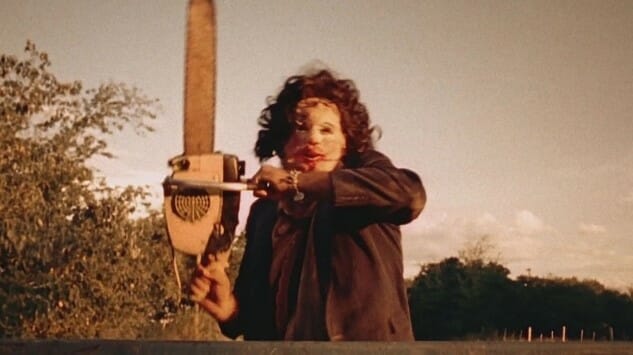The Best Horror Movie of 1974: The Texas Chain Saw Massacre

This post is part of Paste’s Century of Terror project, a countdown of the 100 best horror films of the last 100 years, culminating on Halloween. You can see the full list in the master document, which will collect each year’s individual film entry as it is posted.
The Year
As we get into the mid-1970s, we’re presented with a year that isn’t quite as deep as those that preceded it, but still has an array of very ’70s classics to its name. Whether or not you think it’s appropriate to include the likes of Phantom of the Paradise in this listing, there’s few things more ’70s-tastic in horror than Larry Cohen’s killer baby movie, It’s Alive, which perfectly dates the era.
This is also a groundbreaking year for the arrival of a genre that would come to dominate the late ’70s and early ’80s: The slasher film. Finally, after describing so many movies such as Psycho, Peeping Tom, Blood and Black Lace or A Bay of Blood as “proto-slashers,” we can definitively say the first true slasher is here, and it’s called Black Christmas. Note: This year’s The Texas Chain Saw Massacre also contains more than a few slasher elements, but the film doesn’t fit the tropes of the emerging genre nearly so snugly as Black Christmas.
Bob Clark, who would later, ironically go on to give us A Christmas Story, directed Black Christmas with inspiration drawn largely from the world of urban legends, and the tale of “the babysitter and the man upstairs” that would also serve as the basis for When a Stranger Calls in 1979. The story revolves around a sorority house, where the occupants have been receiving a series of bizarre and threatening phone calls, before girls begin to disappear. At the same time, composed and mature student Jess Bradford is dealing with her own relationship struggles, even as she begins to feel the eyes of a stalking presence on her. Portrayed with uncommon emotional strength by actress Olivia Hussey, Jess proved to be the foundation, in many ways, for the archetype that we later began to refer to as the “Final Girl.” At the same time, though, her individuality, self-assuredness and sexual independence place Jess in a different tier than the more damsel-fied or virginal Final Girls who would often follow in her wake. Beyond the characterization of Jess, however, Black Christmas is notable for its many other contributions to slasher canon: An anonymous, mentally deranged villain who kills for the sheer enjoyment of it; gruesome death scenes; a body count; a cast of nubile victims; POV shots from the killer’s eyes, and more. Perhaps surprisingly, the film didn’t generate an immediate wave of imitators—although there are more quasi-slasher giallo films in the next few years, the genre doesn’t explode into popularity in the U.S. until the sea-change moment of John Carpenter’s Halloween in 1978.
1974 is also home to one of the genre’s great comedies, Young Frankenstein, Mel Brooks’ classic send-up of the Universal Monsters era, which contains far more direct inspiration from Bride of Frankenstein and Son of Frankenstein than viewers who have never seen those movies would likely expect. Venturing out further, we also have the Romero-inspired Spanish/Italian production Let Sleeping Corpses Lie, and Deranged: Confessions of a Necrophile, inspired directly by the infamous serial killings of Ed Gein. Suffice to say, this is certainly a prominent year for “extreme” horror, and that’s before we’ve even discussed The Texas Chain Saw Massacre.
1974 Honorable Mentions: Black Christmas, Young Frankenstein, Let Sleeping Corpses Lie, Deranged: Confessions of a Necrophile, Dead of Night, Captain Kronos — Vampire Hunter, It’s Alive, Madhouse, From Beyond the Grave
-

-

-

-

-

-

-

-

-

-

-

-

-

-

-

-

-

-

-

-

-

-

-

-

-

-

-

-

-

-

-

-

-

-

-

-

-

-

-

-








































